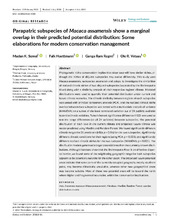| dc.contributor.author | Suwal, Madan Krishna | |
| dc.contributor.author | Huettmann, Falk | |
| dc.contributor.author | Regmi, Ganga Ram | |
| dc.contributor.author | Vetaas, Ole Reidar | |
| dc.date.accessioned | 2019-02-26T17:39:04Z | |
| dc.date.available | 2019-02-26T17:39:04Z | |
| dc.date.issued | 2018-09-04 | |
| dc.Published | Suwal MK, Huettmann F, Regmi GR, Vetaas OR. Parapatric subspecies of Macaca assamensis show a marginal overlap in their predicted potential distribution: Some elaborations for modern conservation management. Ecology and Evolution. 2018:8(19):9712-9727 | eng |
| dc.identifier.issn | 2045-7758 | |
| dc.identifier.uri | https://hdl.handle.net/1956/19154 | |
| dc.description.abstract | Phylogenetic niche conservatism implies that sister taxa will have similar niches, although the niches of disjunct subspecies may evolve differently. This study uses Macaca assamensis, subspecies assamensis and pelops, to investigate the similarities of realized climatic niches of two disjunct subspecies (separated by the Brahmaputra River) along with a similarity analysis of their respective regions’ climate. Modeled distributions were used to quantify their potential distribution under current and future climate scenarios. The climatic similarity between regions of each subspecies was tested with principal component analysis (PCA), and the realized climatic niche overlap between two subspecies was tested with a multivariate analysis of variance (MANOVA) on a subset of the least correlated variables out of 24 publicly available topo‐bioclimatic variables. Tukey's honest significance difference (HSD) was used to test the range differences (on all 24 variables) between subspecies. The potential distribution of both taxa in the current climate and projected future climate was model‐predicted using MaxEnt and Random Forest. We found significantly different climatic ranges for 21 predictors (HSD; p < 0.05) for the two subspecies, significantly different climatic conditions for their regions (using PCA; p < 0.001), and significantly different realized climatic niches for the two subspecies (MANOVA; p < 0.001). The distribution models generated a larger potential area than the currently known distributions. Although literature show that the Brahmaputra River is an effective dispersal barrier, we found some of the neighboring geographic range for both subspecies appears to be potentially suitable for the other taxon. The projected future potential areas indicate that some parts of the currently occupied geography, mostly southern parts, may become climatically unsuitable, whereas other new geographical areas may become suitable. Most of these new potential areas will be toward the north where higher and fragmented mountains, which has conservation implications. | en_US |
| dc.language.iso | eng | eng |
| dc.publisher | Wiley Open Access | eng |
| dc.rights | Attribution CC BY | eng |
| dc.rights.uri | http://creativecommons.org/licenses/by/4.0/ | eng |
| dc.subject | Asia | eng |
| dc.subject | Assamese macaque (Macaca assamensis) | eng |
| dc.subject | Himalaya | eng |
| dc.subject | MaxEnt | eng |
| dc.subject | Random Forest | eng |
| dc.subject | species distribution models | eng |
| dc.title | Parapatric subspecies of Macaca assamensis show a marginal overlap in their predicted potential distribution: Some elaborations for modern conservation management | eng |
| dc.type | Peer reviewed | en_US |
| dc.type | Journal article | en_US |
| dc.date.updated | 2018-09-13T14:04:24Z | |
| dc.description.version | publishedVersion | |
| dc.rights.holder | Copyright 2018 The Authors | en_US |
| dc.identifier.doi | https://doi.org/10.1002/ece3.4405 | |
| dc.identifier.cristin | 1609318 | |
| dc.source.journal | Ecology and Evolution | |

